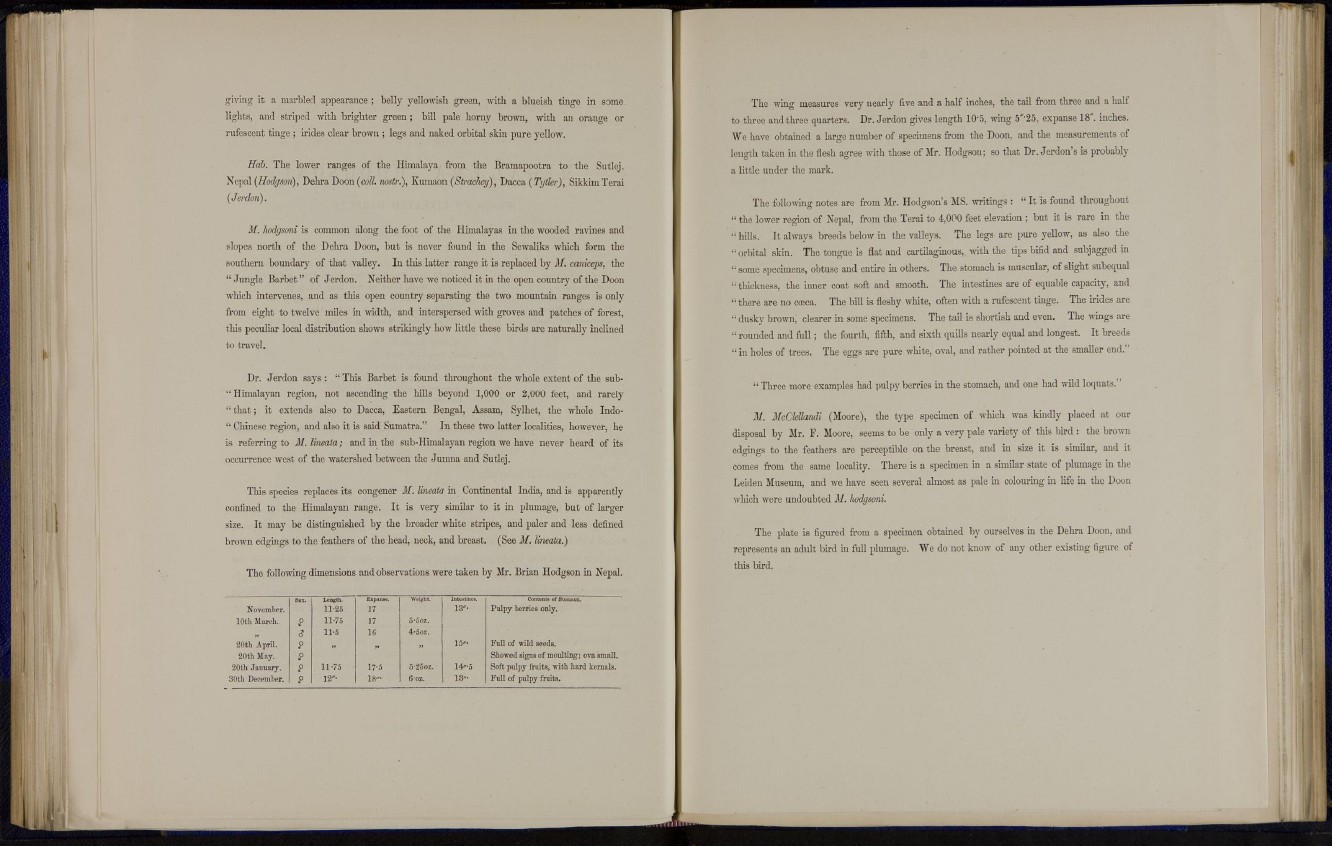
giving it a marbled appearance ; belly yellowish green, with a blueish tinge in some
lights, and striped with brighter green; bill pale horny brown, with an orange or
rufescent tinge ; irides clear brown ; legs and naked orbital skin pure yellow.
Hab. The lower ranges of the Himalaya from the Bramapootra to the Sutlej.
Nepal (Hodgson), Dehra Doon (coll. nostr.), Kumaon (Strachey), Dacca (Tytler), Sikkim Terai
(Jerdon).
M. hodgsoni is common along the foot of the Himalayas in the wooded ravines and
slopes north of the Dehra Doon, but is never found in the Sewaliks which form the
southern boundary of that valley. In tliis latter range i t is replaced by M. caniceps, the
" Jungle B a r b e t " of Jerdon. Neither have we noticed it in the open country of the Doon
winch intervenes, and as this open country separating the two mountain ranges is only
from eight to twelve miles in width, and interspersed with groves and patches of forest,
this peculiar local distribution shows strikingly how little these birds are naturally inclined
to travel.
Dr. Jerdon s a y s : "This Barbet is found throughout the whole extent of the sub-
" Himalayan region, not ascending the lulls beyond 1,000 or 2,000 feet, and rarely
" t h a t ; it extends also to Dacca, Eastern Bengal, Assam, Sylhet, the whole Indo-
" Chinese region, and also it is said Sumatra." In these two latter localities, however, he
is referring to M. lineata; and in the sub-Himalayan region we have never heard of its
occurrence west of the watershed between the Jumna and Sutlej.
This species replaces its congener M. lineata in Continental India, and is apparently
confined to the Himalayan range. It is very similar to it in plumage, but of larger
size. It may be distinguished by the broader white stripes, and paler and less defined
brown edgings t o the feathers of the head, neck, and breast. (See M. lineata.)
The following dimensions and observations were taken by Mr. Brian Hodgson in Nepal.
Sex. Length. Expanse. Weight. lDtcatinua. Contains of Stomach.
November. 11-25 17 13"- Pulpy berries only.
10th March. P 11-75 17 5'5oz.
n
S 11-5 16 4-5oz.
20th April. P „ „ „ 15»- Full of wild seeds.
20th May. P Showed signs of moulting; ova small.
20th January. P 11-75 17-5 5-25oz. U»-5 Soft pulpy fruits, with hard kernals.
30th December. P 12"- 18»- 6-oz. 13»- Full of pulpy fruits.
The wing measures very nearly five and a half inches, the tail from three and a half
t o three and three quarters. Dr. J e r d o n gives length 10-5. wing 5""25. expanse 18". inches.
We have obtained a large number of specimens from the Doon. and the measurements of
length taken in the flesh agree with those of Mr. Hodgson; so that Dr. Jerdon's is probably
a little under the mark.
The following notes are from Mr. Hodgson's MS. writings : " It is found throughout
" the lower region of Nepal, from the Terai to 4.000 feet elevation ; but it is rare in the
" hills. It always breeds below in the valleys. The legs are pure yellow, as also the
"orbital skin. The tongue is flat and cartilaginous, with the tips bifid and subjagged in
'• some specimens, obtuse and entire in others. The stomach is muscular, of slight subequal
'• thickness, the inner coat soft and smooth. The intestines are of equable caj>acity, and
'• t h e r e are no cceca. The bill is fleshy white, often with a rufescent tinge. The irides are
"dusky brown, clearer in some specimens. The tail is shortish and even. The wings are
" rounded and full ; the fourth, fifth, and sixth quills nearly equal and longest. It breeds
" in holes of trees. The eggs are pure white, oval, and rather pointed at the smaller end."
" Three more examples had pulpy berries in the stomach, and one had wild loquats."
M. McClellandi (Moore), the type specimen of which was kindly placed at our
disposal by Mr. F. Moore, seems to be only a very pale variety of this bird : the brown
edgings to the feathers are perceptible on the breast, and in size it is similar, and it
comes from the same locality. There is a specimen in a similar state of plumage in the
Leiden Museum, and we have seen several almost as pale in colouring in life hi the Doon
which were undoubted M. hodgsoni.
The plate is figured from a specimen obtained by ourselves in the Dehra Doon, and
represents an adult bird in full plumage. We do not know of any other existing figure of
this bird.